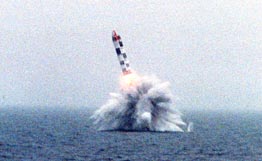During the experimental launch of the Russian Bulava ballistic missile from the nuclear submarine "Dmitriy Donskoy", the missile deviated from the planned path and activated a self-destruct mode

The launch of the Russian naval ballistic missile SS-NX-30 Bulava ("Ala", a type of cold weapon) that took place on October 25, 2006, as part of the set of experiments, failed. The missile was launched from a nuclear submarine "Dmitry Donskoi" (TK-208 Dmitry Donskoi, "Typhoon" model, according to NATO), from an area of the White Sea, at 13:05 UTC in the direction of the "Kura" missile range, on the Kamchatka Peninsula Teka
The military spokesman of the Russian Navy told the Rya Novosti news agency that the launch was underwater, and the submarine's crew performed their tasks as required, but at a certain point in the flight, the missile deviated from its path, and activated the self-destruct mechanism. The reasons for this are still unclear. "A special investigative conference will be established, consisting of the developers and creators of the missile, which will find the reasons for the failure," said the spokesman.
This is the second failed launch of the new missile, out of the last series of four launches. The previous attempt, which took place on September 7 this year, failed due to a malfunction in the systems responsible for the functioning of the first stage of the missile. The launch from December last year was successful, and even took place while the submarine was in motion. The previous experimental launches also showed that "Hala" is a very perspective missile.
Bulava is an intercontinental ballistic missile, which is launched from a nuclear submarine (SLBM) and operates on solid fuel. It is a three-stage missile, with a total length of 12.1 meters, a maximum diameter of 2 meters and an initial weight of 36.8 tons. The pallet includes six split beams with a total weight of 1150 kg. [Source of data: RussianForces]. According to publications in Russia, the range of the missile is about 8,000 km. It was also announced that the warheads of the "gods" move at hypersonic speed, which can perform maneuvers that make it difficult to intercept them (this is in addition to their high level of passive survivability, also against electromagnetic pulses, and the use of "decoys" against anti-aircraft means). According to some experts, because of this the missile can be included in a new type of missile - "quasi-ballistic missiles".
The Bulava missile is known by the pre-NATO code "SS-NX-30" (the letter X signifies that the missile has not yet entered service), and the index R-30 3M30 in Russia. In the protocols of the START (Strategic Arms Reduction Treaty) agreements, for the partnership between Russia and the USA in dismantling ballistic missiles, it appears under the code RSM-56.
"Hala" belongs to the fourth generation of missiles launched from nuclear submarines. It is developed by the Moscow Institute of Thermal Technology (Moscow Institute of Thermal Technology), where they also developed the world's most sophisticated ballistic missile of its kind, SS-27 Topol-M (according to Russian index РС-12М2). The modern submarines of the "Borei" model (project no. 955, according to the Russian code name) will be equipped with the missile. The first submarine of this type, "Yuri Dolgorukii" (Yuri Dolgorukii) will enter service with the Russian Navy in 2007. According to the original plan, Bulava should also enter this year, but it is possible that the failed tests will cause the submarine to go to sea without its missiles.

2 תגובות
My mistake
I didn't notice the date of the article 🙂
At the end of the article it says 2007
Maybe you mean 2017?